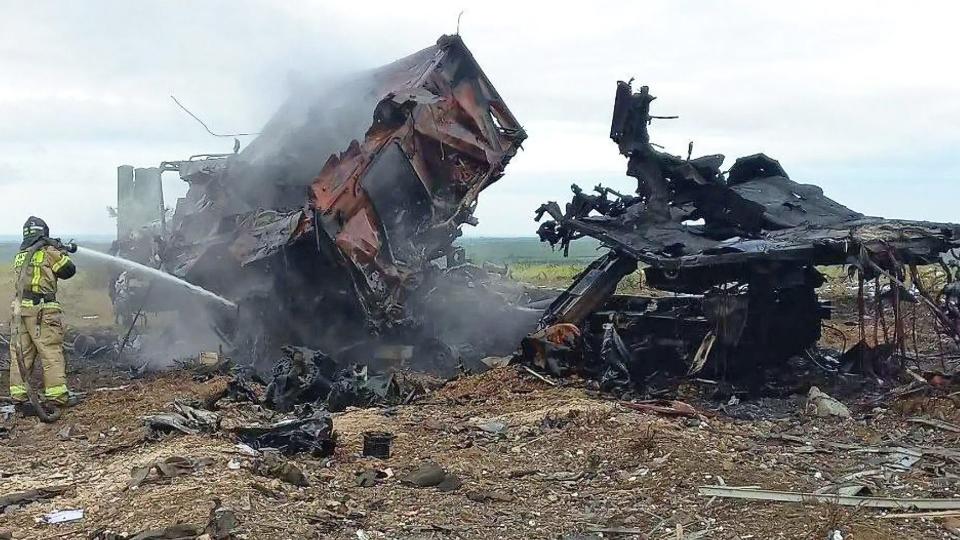Footage has emerged showing the recent destruction of a Russian S-300 or S-400 air defense system by a U.S.-made Army Tactical Missile System (ATACMS), a short-range ballistic missile that Ukraine has used in a string of high-profile strikes since its introduction last year. The video is perhaps the most dramatic demonstration so far of Ukraine’s ongoing efforts to nullify the threat posed by these long-range air defense systems, which threaten Ukrainian aircraft and standoff weapon operations over a radius of up to 250 miles, depending on the variant.
https://www.twitter.com/clashreport/status/1793893686998180059
The attack seems to have taken place outside the airfield of Mospino, in the Russian-occupied Donetsk region of eastern Ukraine, around 30 miles from the front lines. Ukrainian reports suggest that the strike took place on May 22, at around 12:50 local time. According to unconfirmed reports, the Russian air defense system had only been deployed to this location a day before the strike.
https://www.twitter.com/bayraktar_1love/status/1793898184692928665
The video, taken from a Ukrainian drone operating in the vicinity, details the final moments of the S-300/S-400 system before it came under attack. While the drone is obviously surveilling the target area, and recording the results of the strike, it was not necessarily responsible for acquiring the target. The Russian air defense site may well have been located by satellite, or even by its own radar emissions, via electronic support measures (ESM), something which the United States could also assist with.
While apparently unaware of the drone nearby, the Russian air defense system has certainly been alerted to the incoming ATACMS. At least one Ukrainian source claims that five ATACMS missiles were employed, but an attack involving a single missile is also a possibility.
However, in terms of returning fire, at least six missiles are seen being fired by the S-300/S-400, in a last-ditch effort to protect it, and surrounding assets, from the incoming ATACMS. The last air defense missile is fired by the S-300/S-400 only seconds before the ATACMS impacts.
Once the incoming missile arrives, we see the telltale detonation over a wide area of submunitions from the cluster warhead. This rapidly results in secondary explosions from the air defense system’s own missiles — those that weren’t already expended.
As we have explained in the past, the version of ATACMS fitted with a cluster warhead — packed with M74 submunitions — is especially well suited for targeting air defense systems, as well as aircraft in the open, vehicle pools, ammunition dumps, and more.
Imagery had previously come to light showing the aftermath of the attack on Mospino.
Based on analysis of those earlier photos and video, the attack knocked out a pair of 5P85 series transporter-erector-launchers (TELs), plus a 96L6 radar and a command post that are also associated with the S-300/S-400 systems. Another TEL appears to have been damaged in the raid.
https://www.twitter.com/WarVehicle/status/1793631348181373129
For Ukraine, ATACMS is becoming an increasingly popular weapon to tackle Russian long-range air defense systems — both the older S-300 and the more advanced S-400.
Earlier this month, TWZ reported on the ATACMS strikes launched against the air base at Belbek in Russian-occupied Crimea. As well as destroying and/or damaging Russian combat aircraft on the base, these earlier attacks also successfully knocked out portions of an S-300/S-400 air defense system there.
In particular, it appeared that a 92N6 (Grave Stone) radar — the primary long-range detection radar associated with the S-400 — was hit.

Russian ground-based air defenses have extracted a toll on the dwindling number of assets available to the Ukrainian Air Force as well as its Army Aviation. Suppression and destruction of these surface-to-air missiles remains a priority for the Ukrainians. At the same time, the arrival of longer-ranged weapons, like Storm Shadow and long-range one-way attack drones, in Ukrainian hands, have opened up a whole new set of targets at greater distances beyond the front lines. Ensuring these weapons survive to hit their targets is key. Thus opening up holes in Russia’s air defense overlay has been an absolute top priority.
At the same time, Russian has been using the exact same set of tactics, in which Iskander-M short-range ballistic missiles are used for time-sensitive attacks on Ukrainian air defenses.
https://www.twitter.com/Archer83Able/status/1766460798581231953
The latest incident raises some concerns from a Russian perspective, not least the apparent inability of multiple missiles launched by an S-300/S-400 system to successfully defend against an ATACMS attack, although it should be recalled that these surface-to-air missile systems are primarily intended to deal with aircraft targets, with only a limited anti-ballistic missile capability.
Perhaps even more concerning is the fact that Ukraine was able to operate a drone over the air defense system long enough to capture the video and relay it back — not the first time that this has happened. A large static air defense site like this should have point-defense systems to protect it from close-in threats like this, but that often isn’t the case due to how stretched air defense resources are. The continued depletion of advanced Russian air defense assets is certainly an issue that has led to critical gaps in air defenses, especially of critical targets deep inside Russia. This is an issue that is exacerbated by Western sanctions that reduce Russia’s ability to manufacture high-technology weapons at scale.
With the counter-air defense fight now in full swing, with ballistic missiles taking center stage as the weapon of choice, we should see these operations only increase. For Ukraine, the biggest limiting factor to these operations could be the number of ATACMS Ukraine gets and how Russia decides to reposition its air defenses in reaction to attacks. With F-16s entering the war soon, opening up holes in Russia’s most advanced air defenses couldn’t come at a more opportune time.
Contact the author: [email protected]
Source Agencies


